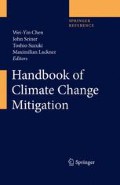Abstract
The efficient use of energy is important to restrain the emission of greenhouse effect gases. Thermal energy storage and heat transport technology enable to utilize the renewable energy and the waste heat which are generally unstable, maldistributed, and thin. They also enable to operate energy devices at a high efficient condition. This chapter introduces some basic research and development activities of thermal energy storage and heat transport, especially latent heat utilization. First, the following fundamental knowledge of thermal energy storage is explained: (1) the functions of thermal energy storage, (2) the classification of storage methods, (3) the characteristics of thermal energy storage materials especially phase change materials (PCMs), and (4) the constitutions of thermal energy storage devices. Other characteristics and challenges of latent heat thermal energy storage (LHTES) which utilize supercooling phenomenon are also explained. Second, several examples of the practical use of LHTES including the utilization of snow and ice are discussed. In the same way, several characteristics and examples of the practical use of the heat transport using latent heat are also explained. Furthermore, recent developments on the following research subjects are introduced: (1) thermal energy storage for hot water supply using the supercooling phenomenon of sugar alcohol, (2) heat storage for space heating using the supercooling of hydrate, (3) the improvement of thermal characteristics of paraffin wax as a PCM, (4) a steam accumulator using sugar alcohol, (5) pipeless heat transport using sugar alcohol or hydrate, and (6) heat transport method using the microencapsulated PCM slurry.
Access this chapter
Tax calculation will be finalised at checkout
Purchases are for personal use only
References
The Japan Society of Mechanical Engineers (JSME) (2009) V-3 Properties of solid, V-4∙1∙1 properties of ordinary water. In: The Japan Society of Mechanical Engineers (JSME) (ed) JSME data book: heat transfer, 5th edn. JSME, Tokyo
Hirano S (2002) Phase change thermal energy storage. J Japan Inst Ener 81–8:691–699
Duffie JA, Beckman WA (1991) 8 energy storage. In: Duffie JA, Beckman WA (eds) Solar engineering of thermal processes, 2nd edn. Wiley, New York
Kosaka M, Asahina T, Taoda H (1980) Recent research on thermal energy storage (7) About latent heat type thermal energy storage materials for space heating/hot water supply. Reports of the Government Industrial Research Institute, Nagoya 29–2:53–62
Hirano S, Saitoh TS, Oya M, Yamazaki M (2001) Temperature dependence of thermophysical properties of disodium hydrogenphosphate dodecahydrate. J Thermophys Heat Trans 15–3:340–346
Kakiuchi H (2008) Development trend of latent heat or chemical thermal energy storage material. In: NTS (ed) Energy storage and transport, Electricity/heat/chemistry. NTS, Tokyo
Telkes M (1954) Composition of matter for the storage of heat, US Patent No. 2677664
Hirano S (2006) 4∙4 Technology for utilizing thermal energy at low temperature. In: Japan Solar Energy Society (ed) Solar energy utilization technology. Ohmsha, Tokyo
Mitsubishi Chemical Engineering (1999) Main ingredients of thermal energy storage materials in STL thermal energy storage system. Mitsubishi Chemical Engineering, Tokyo
Phase Change Products (2009) Product range of phase change materials. Phase Change Products, Western Australia
Hirano S (2009) Research and development trends on latent heat thermal energy storage. J Japan Solar Ener Soc 35–4:11–17
International association for the properties of water and steam (IAPWS) (1998) Revised release on the IAPS formulation 1985 for the thermal conductivity of ordinary water substance. IAPWS, London
New air conditioning system division (2009) Hydrate slurry thermal energy storage air-conditioning system. JFE Engineering, Yokohama
Inada T (2006) Growth control of ice crystals by poly (vinyl alcohol) and antifreeze protein in ice slurries. Chem Engin Sci 61–10:3149–3158
Hirano S (2009) Field test study of cogeneration using supercooled thermal energy storage. In: New energy technology for society, http://www.aist.go.jp/aist_e/research_results/publications/pamphlet/today/new_energy_technology_for_society.pdf 26 May 2011. National Institute of Advanced Industrial Science and Technology (AIST), Tokyo
Hirano S, Takeuchi H (2009) Performance of thermal energy storage unit using supercooling of D-threitol. Papers & Programme of the 8th International conference on sustainable energy technologies, Aachen, Germany, Paper 214
Hirano S, Shibasaki N, Kudo T (2010) Characteristics of thermal storage and radiation in floor heating system using supercooled thermal energy storage. Proceedings of renewable energy 2010, Yokohama, Japan, Paper O-Th-3-2
Hirano S, Saitoh TS (2007) Long-term performance of latent heat thermal energy storage using supercooling. Proceedings of ISES solar world congress 2007 V, Beijing, China, pp 2741–2745
Hoshi A, Saitoh TS (2001) A study of solar steam accumulator with high temperature latent heat thermal energy storage (2nd report; fundamental characteristics of steam accumulator). J Japan Solar Ener Soc 27–5:41–48
Saitoh TS (2008) Final version of solar SHINLA turbine generation system. In: Proceedings of JSES/JWEA joint conference, Tottori, Japan, pp 381–382
Aoki I (2007) Thermal energy storage transport system by erythritol (Waste heat transport system by direct contact latent heat thermal energy storage technology). In: Development of thermal energy transport system. Japan Society of Refrigerating and Air Conditioning Engineers, Tokyo
Kawai A, Kamano H, Okuyama S, Shikata I (2006) Experimental report (I) by latent heat storage transportation system “TransHeat Container.” Kurimoto technical report 54, pp 12–17
Takeuchi H, Pyatenko AT, Yamagishi Y, Sugeno T, Ishige T (1998) Characteristics of microencapsulated phase change material slurry as energy transportation refrigerant. Therm Sci Engin 6–1:162–167
Ueda M, Yasuda M (2004) Microbial production of rare sugars by biotransformation and fermentation: L-Ribose and D-Threitol. Monthly fine chem 33(9):52–60
Author information
Authors and Affiliations
Corresponding author
Editor information
Editors and Affiliations
Rights and permissions
Copyright information
© 2012 Springer Science+Business Media, LLC
About this entry
Cite this entry
Hirano, S. (2012). Thermal Energy Storage and Transport. In: Chen, WY., Seiner, J., Suzuki, T., Lackner, M. (eds) Handbook of Climate Change Mitigation. Springer, New York, NY. https://doi.org/10.1007/978-1-4419-7991-9_20
Download citation
DOI: https://doi.org/10.1007/978-1-4419-7991-9_20
Publisher Name: Springer, New York, NY
Print ISBN: 978-1-4419-7990-2
Online ISBN: 978-1-4419-7991-9
eBook Packages: EngineeringReference Module Computer Science and Engineering

